Unit 3 How do you get to school Section B 2a-2c课件(共31张PPT)
文档属性
| 名称 | Unit 3 How do you get to school Section B 2a-2c课件(共31张PPT) | 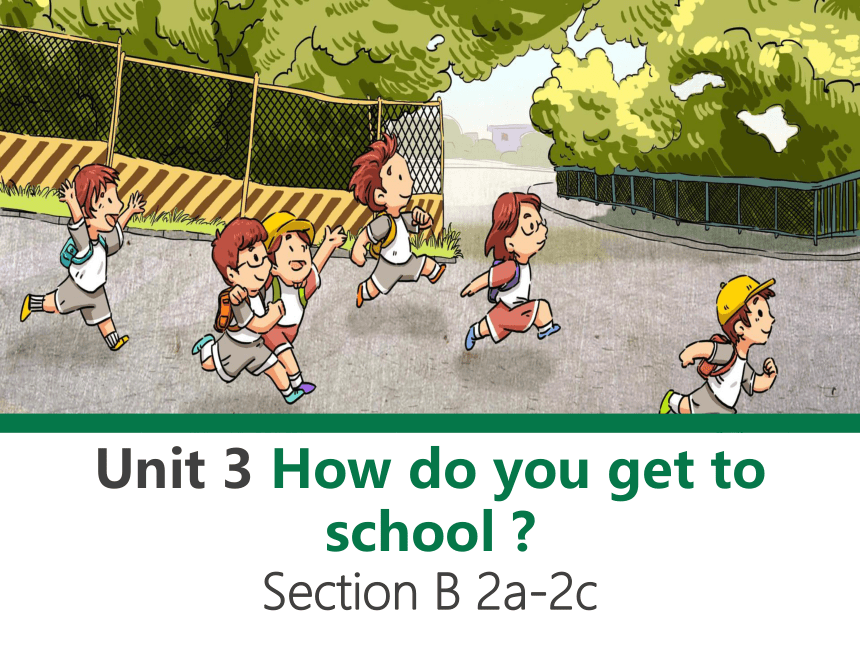 | |
| 格式 | pptx | ||
| 文件大小 | 5.3MB | ||
| 资源类型 | 教案 | ||
| 版本资源 | 人教新目标(Go for it)版 | ||
| 科目 | 英语 | ||
| 更新时间 | 2023-03-19 16:03:20 | ||
图片预览

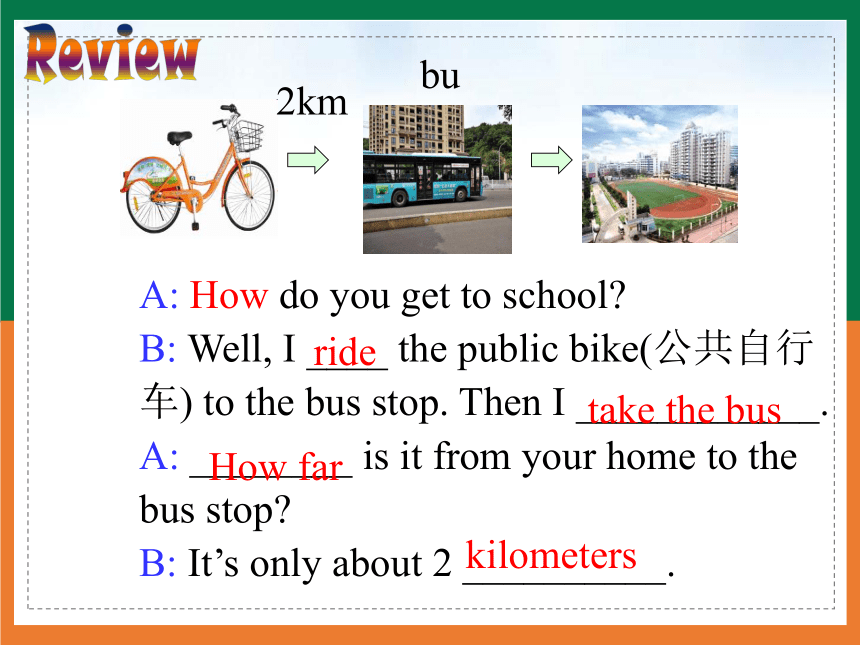
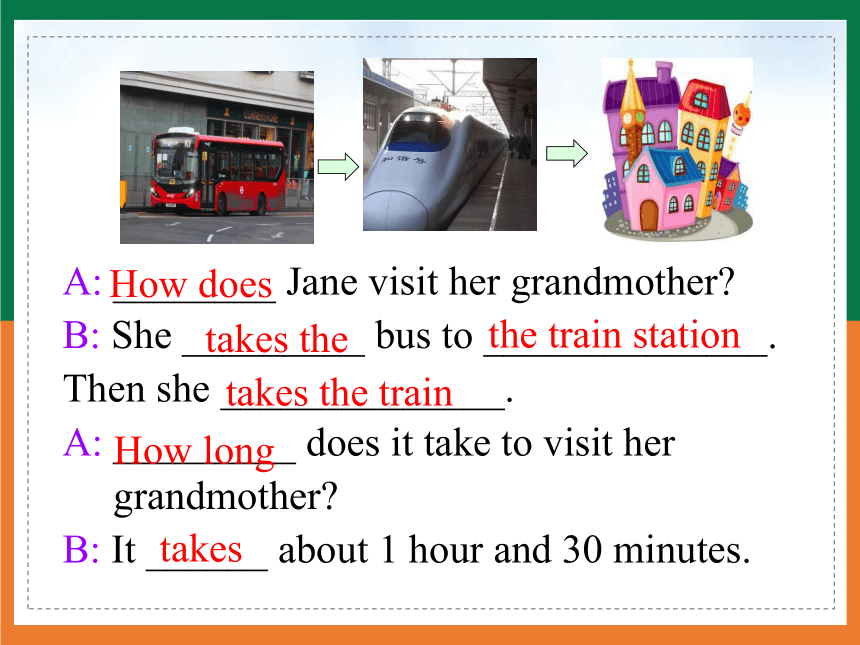
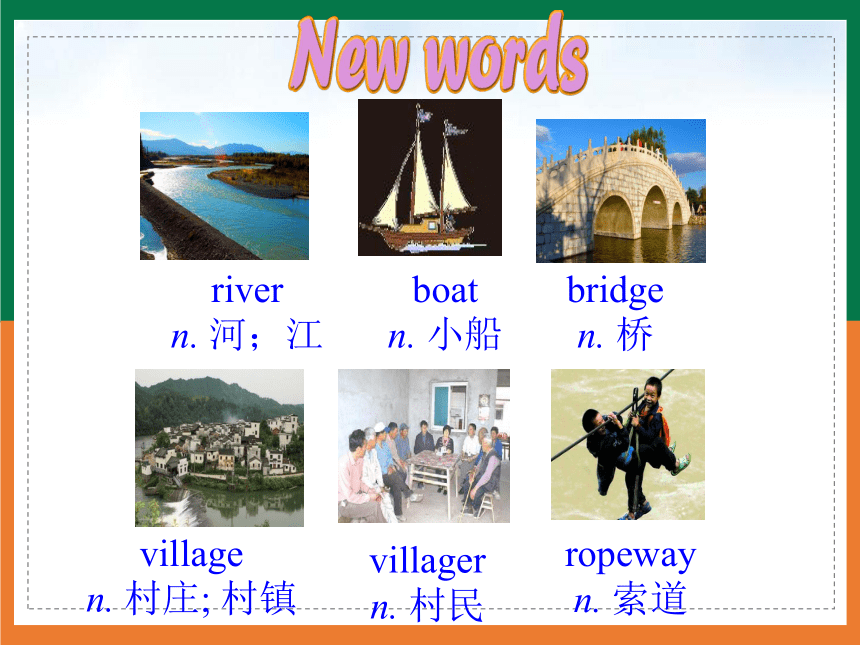
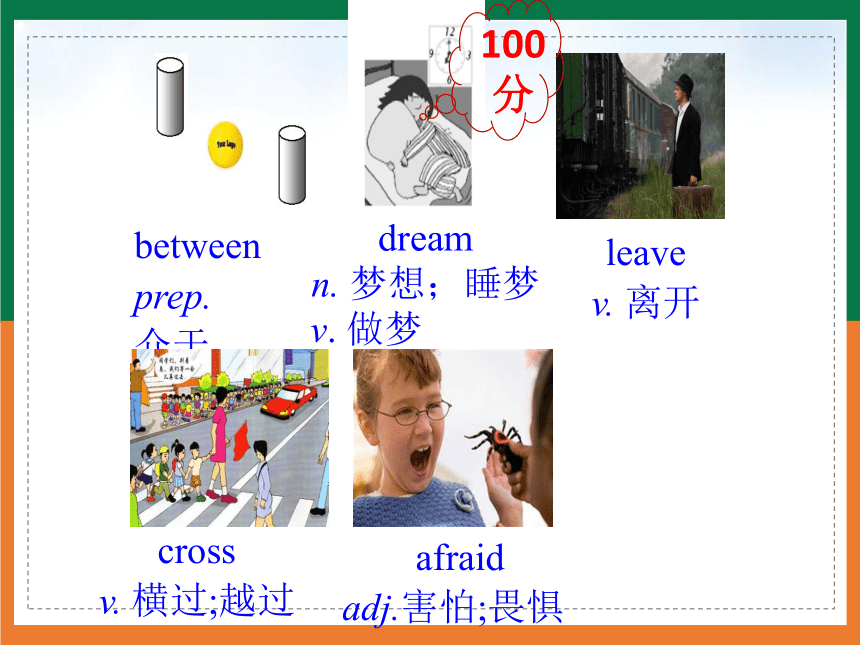
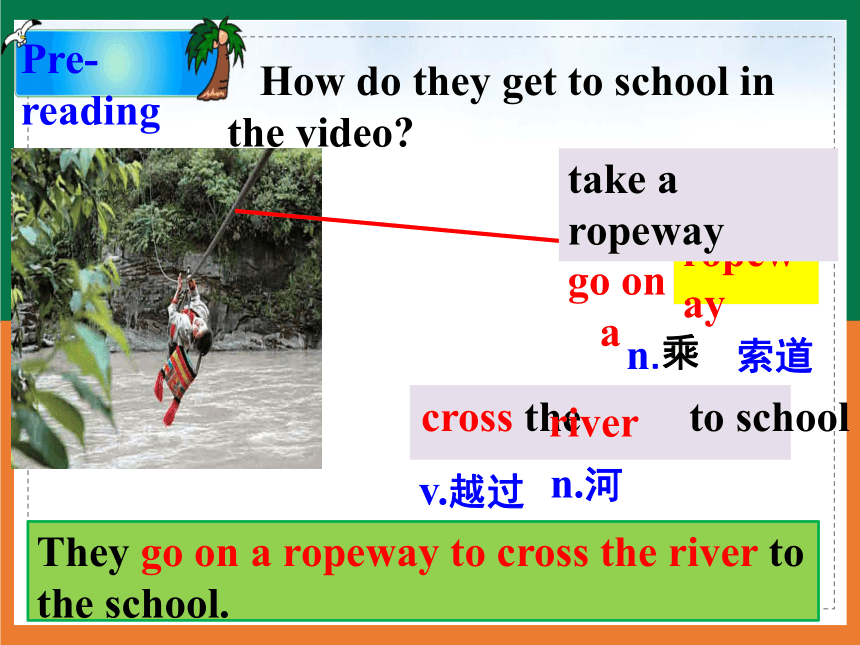
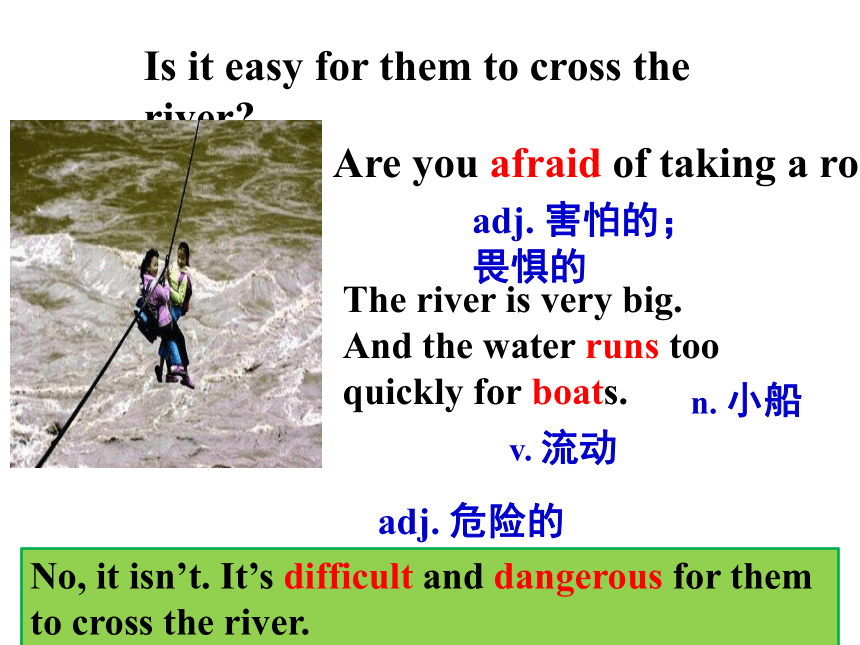

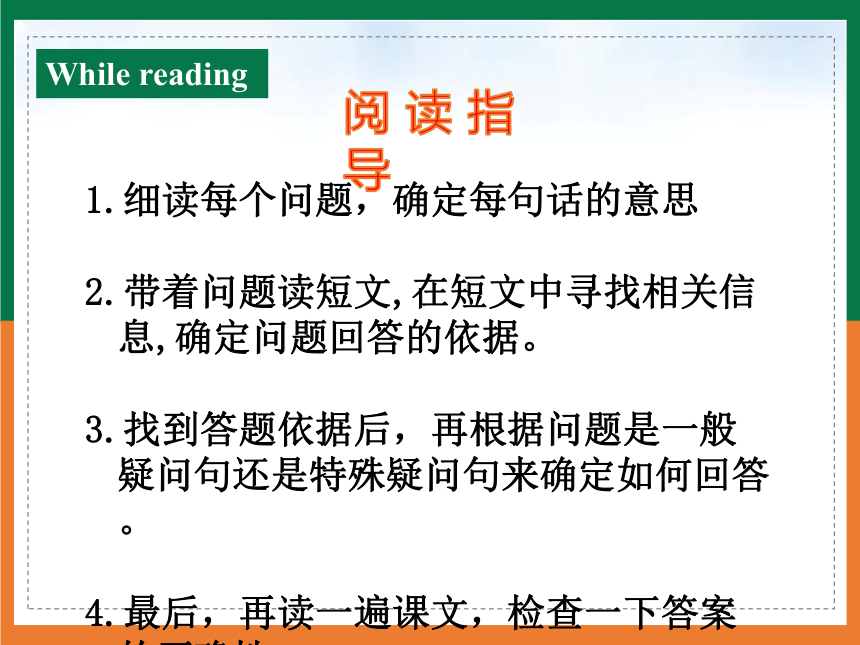
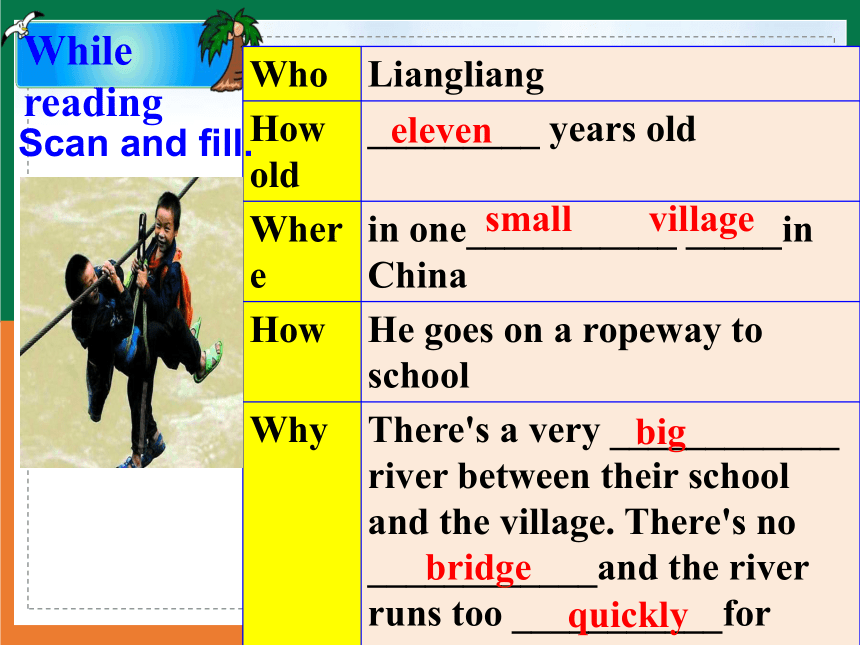
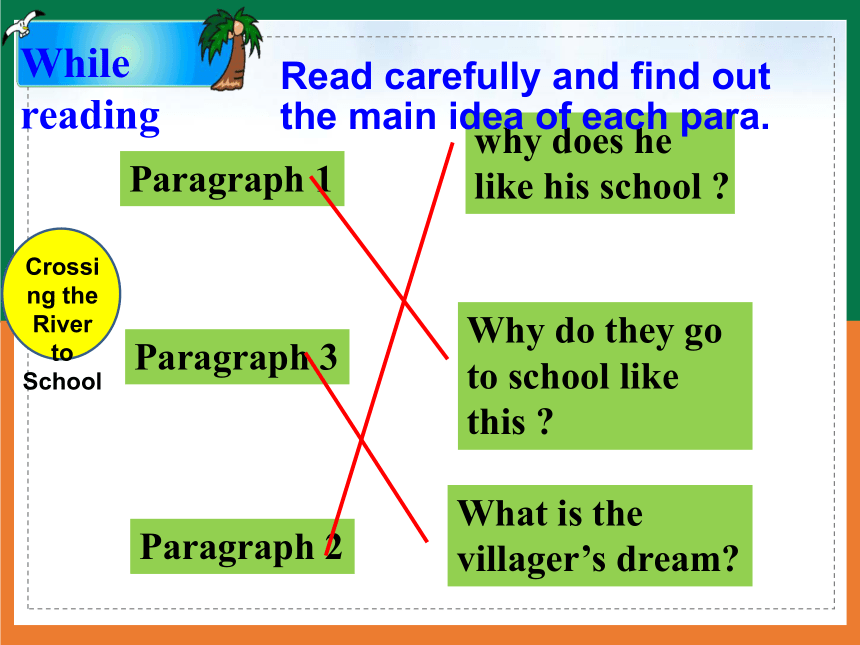
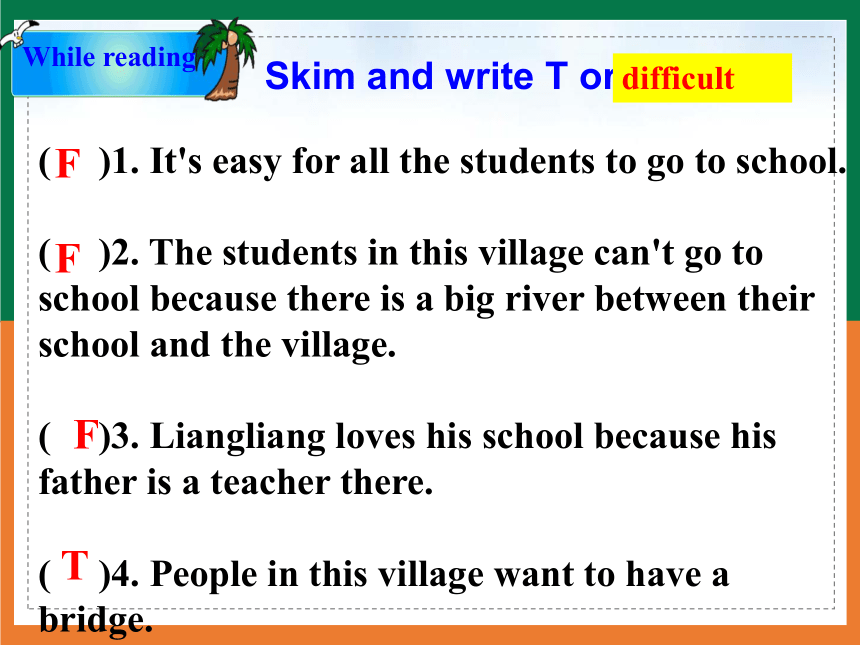
文档简介
(共31张PPT)
Unit 3 How do you get to school
Section B 2a-2c
A: How do you get to school
B: Well, I ____ the public bike(公共自行车) to the bus stop. Then I ____________.
A: ________ is it from your home to the bus stop
B: It’s only about 2 __________.
bus
ride
take the bus
How far
kilometers
2km
A: ________ Jane visit her grandmother
B: She _________ bus to ______________. Then she ______________.
A: _________ does it take to visit her
grandmother
B: It ______ about 1 hour and 30 minutes.
How does
takes the
the train station
takes the train
How long
takes
boat
n. 小船
river
n. 河;江
bridge
n. 桥
village
n. 村庄; 村镇
villager
n. 村民
ropeway
n. 索道
dream
n. 梦想;睡梦
v. 做梦
between prep.
介于……之间
100 分
leave
v. 离开
afraid
adj.害怕;畏惧
cross
v. 横过;越过
go on a
ropeway
take a ropeway
n. 索道
乘
How do they get to school in the video
Pre-reading
cross the to school
river
v.越过
n.河
They go on a ropeway to cross the river to the school.
Is it easy for them to cross the river
No, it isn’t. It’s difficult and dangerous for them to cross the river.
Are you afraid of taking a ropeway
adj. 害怕的;畏惧的
The river is very big.
And the water runs too quickly for boats.
v. 流动
n. 小船
adj. 危险的
While reading
Listen and answer.
1. Who is Liangliang
2. Where do they live
3. How does Liangliang go to school every school day
An eleven-year-old boy.
They live in a small village.
He goes on a ropeway to school.
1.细读每个问题,确定每句话的意思
带着问题读短文,在短文中寻找相关信息,确定问题回答的依据。
3.找到答题依据后,再根据问题是一般疑问句还是特殊疑问句来确定如何回答。
4.最后,再读一遍课文,检查一下答案的正确性。
阅 读 指 导
While reading
While reading
Who Liangliang
How old _________ years old
Where in one___________ _____in China
How He goes on a ropeway to school
Why There's a very ____________ river between their school and the village. There's no ____________and the river runs too ___________for boats
eleven
small village
quickly
big
bridge
Scan and fill.
While reading
Paragraph 1
Paragraph 2
Paragraph 3
Why do they go to school like this
why does he like his school
What is the villager’s dream
Read carefully and find out the main idea of each para.
Crossing the River to School
While reading
Skim and write T or F.
( )1. It's easy for all the students to go to school.
( )2. The students in this village can't go to school because there is a big river between their school and the village.
( )3. Liangliang loves his school because his father is a teacher there.
( )4. People in this village want to have a bridge.
F
F
F
T
difficult
Ways to go to school
Reasons
…..go on a ropeway
a big river
no bridge
the river runs too quickly
Read Para.1 carefully and fill in the chart.
Liangliang’s father is a teacher.
2. Liangliang is not afraid of crossing the river on a ropeway.
3. The boy likes his school because he likes his classmates and teacher.
Are the following statements true (T) or false (F)
T
F
T
Read Para.2 carefully and complete the task.
Read Para.3 carefully and complete the task.
1. Do many villagers usually leave the village
2. What is the villagers’ dream
Their dream is to have a bridge.
No, they don’t.
Answer the questions.
仔细阅读课文,完成下面的图表,每空不超过四个单词。
difficult
quickly
go on a ropeway
11-year-old
cross the river
have a bridge
1. between … and … 在……与……之间
between 是个介词,表示在两者之间。
如:Mary is between Jane and Linda in the line.
在队伍中,玛丽在简和琳达之间。
Language points
2. There a very big river between their school and the village.
there be侧重于客观存在的“有”,强调存在的状态。在there be结构中,主语应放在be动词之后,并且be动词的形式应与主语保持一致。如:
There are many apples on the tree.
There is a cup on the table.
There is a boy and two girls in the classroom.
There are two girls and a boy in the classroom.
【拓展】
have侧重于主观方面,强调“所属” 关系,表示“拥有,占有,具有”。在这一结构中,have与主语保持人称和数的一致。如:
She has a nice schoolbag.
I have a red bike.
Do they have six basketballs
4. like 像, 在这里作介词,而不是动词。
The fish looks like a big boat.
那条鱼看起来像条大船 。(介词)
Jane likes history very much.
简很喜欢历史。 (动词)
5. come true 实现;成为现实
I think our dream can come true.
我认为我们的梦想能实现。
6. There is no bridge and the river runs too quickly for boats.
河上根本没有桥,而且水流很急,不适宜小船摆渡。
(1) no “完全不、根本没有”,在这里构成否定句。当no 用于构成否定句时,主要用于名词前,强调否定其后面的名词。如:
There is no apple in the fridge. 冰箱里没有苹果了。
(2) run 在这里表示“液体流动”。
它在不同的语境中有不同的用法和含义。例如:
Who runs the business
生意是谁经营的
“run”表示 “管理;经营”
② John run a car into a park.
John把车开进了公园。
“run”表示 “使行驶;驾驶”
③ The road runs north.这条路伸向北方.
“run”表示 “延伸”
④ “run”可以做名词 “奔跑,路程”
Let’s go for a run across the field.
咱们去跑步,跑过那片田野吧。
It is an hour's run by train from here to London.
从此地到伦敦搭火车有一小时的行程。
7. One 11-year-old boy, Liangliang, crosses the river every school day.
一个11岁的男孩—亮亮,每天过河上学 。
11-year-old 为多个词汇构成的复合形容词,用连字符“-”链接,用来修饰名词 boy。这种结构还有很多,例如:
a four-day trip 一个四天的旅行
a 30-page book 一本30页的书
a five-minute walk 一段5分钟的路
注意:这里的“year、day、page、walk”都是用单数。
8. The bus ride is never boring because I always talk to my classmates.
坐公交车从来不会无聊,因为我可以经常和同学聊天。
在这里,ride作为名词,表示“乘车、行程” 。
give sb a ride 让某人搭便车
ride 也可以做动词,表示“乘车、乘坐”如:
I often ride my bike to school.
我经常骑自行车去学校。
Quiz
Look! There are some boats on the r____.
2. Who is the boy b______ your mother and father
3. — How old is your sister
— She’s twelve y____ old.
4. My mom always says “Have a good d_____!” before I go to bed.
5. When the girl sees the dog, she’s always a______.
根据句意及首字母提示完成单词。
iver
etween
ears
ream
fraid
1. You can see _____ books on his desk.
2. Mrs. Han is ____ a mother to us. We all love her very much.
3. I often walk to the bus ____ to take the bus.
4. The students in the village go to school by ______.
5. How can we _____ the river
many
like
stop
boat
cross
从方框中选择适当的单词并用其正确形式完成句子。
stop, cross, many, boat, like
1. Do they go to school by bus or _______
(骑自行车)
2. _________ (因……而感谢) helping me with my homework.
3. There are lots of people in the _______ _______ (地铁站).
4. I _____ (到达) school at seven thirty in the morning.
5. What do you _______ (认为) the school trip
by bike
Thanks for
station
get to
think of
根据句意及汉语提示,用适当的短语完成句子。
subway
完成本课时相关练习题。
Homework
Thanks for listening!
Unit 3 How do you get to school
Section B 2a-2c
A: How do you get to school
B: Well, I ____ the public bike(公共自行车) to the bus stop. Then I ____________.
A: ________ is it from your home to the bus stop
B: It’s only about 2 __________.
bus
ride
take the bus
How far
kilometers
2km
A: ________ Jane visit her grandmother
B: She _________ bus to ______________. Then she ______________.
A: _________ does it take to visit her
grandmother
B: It ______ about 1 hour and 30 minutes.
How does
takes the
the train station
takes the train
How long
takes
boat
n. 小船
river
n. 河;江
bridge
n. 桥
village
n. 村庄; 村镇
villager
n. 村民
ropeway
n. 索道
dream
n. 梦想;睡梦
v. 做梦
between prep.
介于……之间
100 分
leave
v. 离开
afraid
adj.害怕;畏惧
cross
v. 横过;越过
go on a
ropeway
take a ropeway
n. 索道
乘
How do they get to school in the video
Pre-reading
cross the to school
river
v.越过
n.河
They go on a ropeway to cross the river to the school.
Is it easy for them to cross the river
No, it isn’t. It’s difficult and dangerous for them to cross the river.
Are you afraid of taking a ropeway
adj. 害怕的;畏惧的
The river is very big.
And the water runs too quickly for boats.
v. 流动
n. 小船
adj. 危险的
While reading
Listen and answer.
1. Who is Liangliang
2. Where do they live
3. How does Liangliang go to school every school day
An eleven-year-old boy.
They live in a small village.
He goes on a ropeway to school.
1.细读每个问题,确定每句话的意思
带着问题读短文,在短文中寻找相关信息,确定问题回答的依据。
3.找到答题依据后,再根据问题是一般疑问句还是特殊疑问句来确定如何回答。
4.最后,再读一遍课文,检查一下答案的正确性。
阅 读 指 导
While reading
While reading
Who Liangliang
How old _________ years old
Where in one___________ _____in China
How He goes on a ropeway to school
Why There's a very ____________ river between their school and the village. There's no ____________and the river runs too ___________for boats
eleven
small village
quickly
big
bridge
Scan and fill.
While reading
Paragraph 1
Paragraph 2
Paragraph 3
Why do they go to school like this
why does he like his school
What is the villager’s dream
Read carefully and find out the main idea of each para.
Crossing the River to School
While reading
Skim and write T or F.
( )1. It's easy for all the students to go to school.
( )2. The students in this village can't go to school because there is a big river between their school and the village.
( )3. Liangliang loves his school because his father is a teacher there.
( )4. People in this village want to have a bridge.
F
F
F
T
difficult
Ways to go to school
Reasons
…..go on a ropeway
a big river
no bridge
the river runs too quickly
Read Para.1 carefully and fill in the chart.
Liangliang’s father is a teacher.
2. Liangliang is not afraid of crossing the river on a ropeway.
3. The boy likes his school because he likes his classmates and teacher.
Are the following statements true (T) or false (F)
T
F
T
Read Para.2 carefully and complete the task.
Read Para.3 carefully and complete the task.
1. Do many villagers usually leave the village
2. What is the villagers’ dream
Their dream is to have a bridge.
No, they don’t.
Answer the questions.
仔细阅读课文,完成下面的图表,每空不超过四个单词。
difficult
quickly
go on a ropeway
11-year-old
cross the river
have a bridge
1. between … and … 在……与……之间
between 是个介词,表示在两者之间。
如:Mary is between Jane and Linda in the line.
在队伍中,玛丽在简和琳达之间。
Language points
2. There a very big river between their school and the village.
there be侧重于客观存在的“有”,强调存在的状态。在there be结构中,主语应放在be动词之后,并且be动词的形式应与主语保持一致。如:
There are many apples on the tree.
There is a cup on the table.
There is a boy and two girls in the classroom.
There are two girls and a boy in the classroom.
【拓展】
have侧重于主观方面,强调“所属” 关系,表示“拥有,占有,具有”。在这一结构中,have与主语保持人称和数的一致。如:
She has a nice schoolbag.
I have a red bike.
Do they have six basketballs
4. like 像, 在这里作介词,而不是动词。
The fish looks like a big boat.
那条鱼看起来像条大船 。(介词)
Jane likes history very much.
简很喜欢历史。 (动词)
5. come true 实现;成为现实
I think our dream can come true.
我认为我们的梦想能实现。
6. There is no bridge and the river runs too quickly for boats.
河上根本没有桥,而且水流很急,不适宜小船摆渡。
(1) no “完全不、根本没有”,在这里构成否定句。当no 用于构成否定句时,主要用于名词前,强调否定其后面的名词。如:
There is no apple in the fridge. 冰箱里没有苹果了。
(2) run 在这里表示“液体流动”。
它在不同的语境中有不同的用法和含义。例如:
Who runs the business
生意是谁经营的
“run”表示 “管理;经营”
② John run a car into a park.
John把车开进了公园。
“run”表示 “使行驶;驾驶”
③ The road runs north.这条路伸向北方.
“run”表示 “延伸”
④ “run”可以做名词 “奔跑,路程”
Let’s go for a run across the field.
咱们去跑步,跑过那片田野吧。
It is an hour's run by train from here to London.
从此地到伦敦搭火车有一小时的行程。
7. One 11-year-old boy, Liangliang, crosses the river every school day.
一个11岁的男孩—亮亮,每天过河上学 。
11-year-old 为多个词汇构成的复合形容词,用连字符“-”链接,用来修饰名词 boy。这种结构还有很多,例如:
a four-day trip 一个四天的旅行
a 30-page book 一本30页的书
a five-minute walk 一段5分钟的路
注意:这里的“year、day、page、walk”都是用单数。
8. The bus ride is never boring because I always talk to my classmates.
坐公交车从来不会无聊,因为我可以经常和同学聊天。
在这里,ride作为名词,表示“乘车、行程” 。
give sb a ride 让某人搭便车
ride 也可以做动词,表示“乘车、乘坐”如:
I often ride my bike to school.
我经常骑自行车去学校。
Quiz
Look! There are some boats on the r____.
2. Who is the boy b______ your mother and father
3. — How old is your sister
— She’s twelve y____ old.
4. My mom always says “Have a good d_____!” before I go to bed.
5. When the girl sees the dog, she’s always a______.
根据句意及首字母提示完成单词。
iver
etween
ears
ream
fraid
1. You can see _____ books on his desk.
2. Mrs. Han is ____ a mother to us. We all love her very much.
3. I often walk to the bus ____ to take the bus.
4. The students in the village go to school by ______.
5. How can we _____ the river
many
like
stop
boat
cross
从方框中选择适当的单词并用其正确形式完成句子。
stop, cross, many, boat, like
1. Do they go to school by bus or _______
(骑自行车)
2. _________ (因……而感谢) helping me with my homework.
3. There are lots of people in the _______ _______ (地铁站).
4. I _____ (到达) school at seven thirty in the morning.
5. What do you _______ (认为) the school trip
by bike
Thanks for
station
get to
think of
根据句意及汉语提示,用适当的短语完成句子。
subway
完成本课时相关练习题。
Homework
Thanks for listening!
同课章节目录
- Unit 1 Can you play the guitar?
- Section A
- Section B
- Unit 2 What time do you go to school?
- Section A
- Section B
- Unit 3 How do you get to school?
- Section A
- Section B
- Unit 4 Don't eat in class.
- Section A
- Section B
- Unit 5 Why do you like pandas?
- Section A
- Section B
- Unit 6 I'm watching TV.
- Section A
- Section B
- Review of Units 1-6
- Unit 7 It's raining!
- Section A
- Section B
- Unit 8 Is there a post office near here?
- Section A
- Section B
- Unit 9 What does he look like?
- Section A
- Section B
- Unit 10 I'd like some noodles.
- Section A
- Section B
- Unit 11 How was your school trip?
- Section A
- Section B
- Unit 12 What did you do last weekend?
- Section A
- Section B
